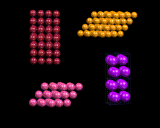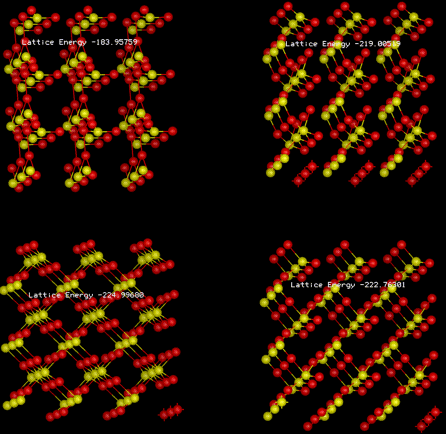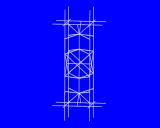More Complicated Structures
 |
Before we continue to explore the diverse and rich range of crystal architectures, we need to answer one very basic question: why do atoms form ordered structures in three dimensions? What drives the adoption of these extraordinary regular and symmetric arrangements? The answer is surprisingly simple and straightforward: ordered arrangements of atoms invariably have lower energies than those of disordered structures. For the simplest structures such as those of metals shown this is intuitively obvious. Since the atoms attract each other, they will pack together in the most efficient possible way to achieve the maximum density. And the structures shown are simply the best (i.e. the highest density) ways of packing spheres in three dimensions. (In the same way, we know that when we pack together billiard balls on a table, the most effective packing gives an ordered arrangement.)
When we look at more complex structures, it is less apparent that ordering must lead to lower energies. Yet this principle still applies, as we can show with 'computer experiments', a simple example of which is illustrated in the image above. The experiment concerns the important compound titanium dioxide (which is the major constituent of white paint and is also used in solar energy devices). We start the experiment with a random arrangement of titanium and oxygen atoms packed to give the right density for the compound. We then tell the computer to find the lowest energy configurations of the assembly of atoms using information supplied on the forces acting between the atoms; that is, we use the principle of energy minimisation. The image shows successive configurations on the way to the lowest energy structure. We see, remarkably, that order begins to emerge; and that when we finally reach the energy minimum, we have a fully ordered structure; one, moreover, which turns out to be an excellent model for the known crystal structure of the rutile phase of TiO2. Simply from the basis of the forces acting between the atoms, we have shown that the lowest energy atomic arrangement is the observed crystal structure.
 |
Atoms and molecules order when they are packed in three dimensions because the ordered structures are the most 'energy efficient' arrangements. However, the deep drive in nature towards disorder always ensures that elements of disorder are present in crystals; moreover, as we saw in the last chapter, the drive to disorder increases with temperature which eventually leads to the crystal melting: the order of the crystalline phase is lost in the disordered, but equally fascinating, structures of liquids. And, as we will learn later, we can freeze the disordered mobile liquid structures into solids that retain the disordered atomic arrangements, which is the defining feature of the structure at the atomic level of glasses. The structures of glassy materials will be explored after we have extended our view of crystalline architectures.
 |